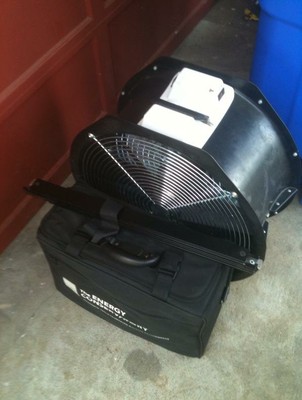 It’s not often that I actually see an energy efficiency program at work on the ground. But last Friday I got the chance to visit a family in Portland whose home had been retrofitted through the Clean Energy Works Program. I have touted Clean Energy works again and again as an example of the way a residential retrofit program should work—and my site visit validated my view that Clean Energy works has it right, demonstrating that affordable and easy financing makes the difference between getting frustrated and getting retrofits. What tipped the scales for the homeowners was how easy it all was: to get an audit, get the work completed, and pay for the loan on their energy bill. Other cities should try to duplicate Clean Energy Works.
It’s not often that I actually see an energy efficiency program at work on the ground. But last Friday I got the chance to visit a family in Portland whose home had been retrofitted through the Clean Energy Works Program. I have touted Clean Energy works again and again as an example of the way a residential retrofit program should work—and my site visit validated my view that Clean Energy works has it right, demonstrating that affordable and easy financing makes the difference between getting frustrated and getting retrofits. What tipped the scales for the homeowners was how easy it all was: to get an audit, get the work completed, and pay for the loan on their energy bill. Other cities should try to duplicate Clean Energy Works.
The owners of the home I visited had been faced with wintertime energy bills of three to four hundred dollars to heat their 2,400 square foot home. The house is at least 80 years, old with several additions and heated by electric baseboards. The owner heard about the program through one of its marketing efforts, got on-line and completed the intake form. The Energy Trust of Oregon assigned an “energy advocate” to the home, based on the online form.
I can’t underestimate the importance of the advocate’s role. His job is to do many of the things a homeowner might have to do themselves, things that might push the project down the list of projects a homeowner might be considering. The advocate works directly with the contractor, helps with scheduling the work, reviews the work when it’s done, and generally is single point of contact. The advocate was also at the home once the work was finished. He checked out the work done by the contractor, and set up a blower door test to be sure the work—new ductless heating and cooling, plus insulation—actually improved the home’s efficiency.
When I asked a family member about the work, and why she wanted it done, her answer was pretty simple: it was easy and affordable. She also cited the fact that in the winter it had been uncomfortable, forcing the family to turn on all the baseboard heaters all the time, just to keep the home warm. The combination of no insulation and inefficient heating meant all the energy poured into the heaters quickly found its way outside. And she really appreciated having a single point of contact to manage the work.
It’s hugely important that the program is easy to use for homeowners. But behind the scenes, it’s another story. There is almost an inverse relationship between how easy it was for this family to tap into the program, and the complexity of setting up the program itself. The Clean Energy Works program is made possible largely because of federal stimulus dollars. The stimulus dollars fund a loan loss reserve account which lowers the interest rate for the family borrowing money for the retrofit. That loan loss reserve means that if this family stops paying the bills, the bank—Shorebank Cascadia—will be able to cover the money it would lose. That in turn means the bank can charge a lower interest rate. (In fact, the loan loss reserve makes the loan possible in the first place.) And all of this required collaboration between the City of Portland, the local utility, Energy Trust of Oregon, and Shorebank. But the program shows that where there is a will, there is a way to align the interests of lenders, clean energy advocates, utilities, and homeowners to get easy, affordable loans that can be paid back on their regular utility bill—usually called “on-bill financing.”
So far, Clean Energy Works has completed about 70 projects. The program is picking up the pace, and looking now to expand to the multi-family sector where split incentives are a big problem.
Seattle recently was awarded $20 million for retrofits like the one I saw being completed in Portland—a healthy sum to get Clean Energy Works Seattle started. Seattle would be wise to focus on the key elements of what makes the Portland program work:
* A simple on-line application process
* Low interest loans
* An energy advocate
* On-bill payback of the loan
These features are important to the people who need the retrofits. It isn’t easy to organize all of these elements together, but if the City does, it will ensure that Seattle families can get the same benefits—efficiencies, comfort, saved money, jobs, reduced emissions—as the family I visited in Portland.







